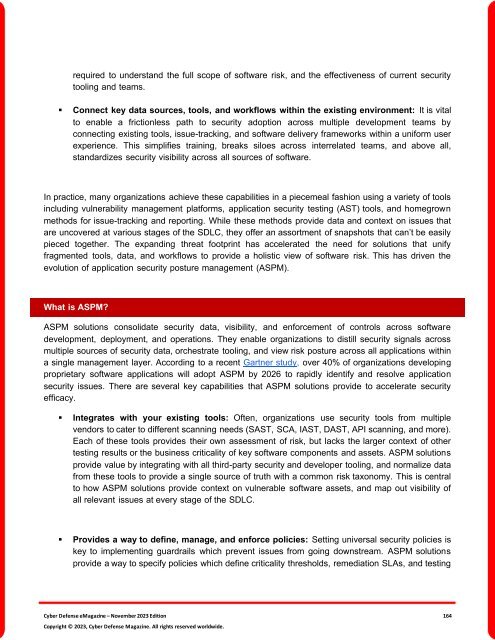The Cyber Defense eMagazine November Edition for 2023
Cyber Defense eMagazine November Edition for 2023 #CDM #CYBERDEFENSEMAG @CyberDefenseMag by @Miliefsky a world-renowned cyber security expert and the Publisher of Cyber Defense Magazine as part of the Cyber Defense Media Group as well as Yan Ross, Editor-in-Chief and many more writers, partners and supporters who make this an awesome publication! 196 page November Edition fully packed with some of our best content. Thank you all and to our readers! OSINT ROCKS! #CDM #CDMG #OSINT #CYBERSECURITY #INFOSEC #BEST #PRACTICES #TIPS #TECHNIQUES
Cyber Defense eMagazine November Edition for 2023 #CDM #CYBERDEFENSEMAG @CyberDefenseMag by @Miliefsky a world-renowned cyber security expert and the Publisher of Cyber Defense Magazine as part of the Cyber Defense Media Group as well as Yan Ross, Editor-in-Chief and many more writers, partners and supporters who make this an awesome publication! 196 page November Edition fully packed with some of our best content. Thank you all and to our readers! OSINT ROCKS! #CDM #CDMG #OSINT #CYBERSECURITY #INFOSEC #BEST #PRACTICES #TIPS #TECHNIQUES
Create successful ePaper yourself
Turn your PDF publications into a flip-book with our unique Google optimized e-Paper software.
equired to understand the full scope of software risk, and the effectiveness of current security<br />
tooling and teams.<br />
• Connect key data sources, tools, and workflows within the existing environment: It is vital<br />
to enable a frictionless path to security adoption across multiple development teams by<br />
connecting existing tools, issue-tracking, and software delivery frameworks within a uni<strong>for</strong>m user<br />
experience. This simplifies training, breaks siloes across interrelated teams, and above all,<br />
standardizes security visibility across all sources of software.<br />
In practice, many organizations achieve these capabilities in a piecemeal fashion using a variety of tools<br />
including vulnerability management plat<strong>for</strong>ms, application security testing (AST) tools, and homegrown<br />
methods <strong>for</strong> issue-tracking and reporting. While these methods provide data and context on issues that<br />
are uncovered at various stages of the SDLC, they offer an assortment of snapshots that can’t be easily<br />
pieced together. <strong>The</strong> expanding threat footprint has accelerated the need <strong>for</strong> solutions that unify<br />
fragmented tools, data, and workflows to provide a holistic view of software risk. This has driven the<br />
evolution of application security posture management (ASPM).<br />
What is ASPM?<br />
ASPM solutions consolidate security data, visibility, and en<strong>for</strong>cement of controls across software<br />
development, deployment, and operations. <strong>The</strong>y enable organizations to distill security signals across<br />
multiple sources of security data, orchestrate tooling, and view risk posture across all applications within<br />
a single management layer. According to a recent Gartner study, over 40% of organizations developing<br />
proprietary software applications will adopt ASPM by 2026 to rapidly identify and resolve application<br />
security issues. <strong>The</strong>re are several key capabilities that ASPM solutions provide to accelerate security<br />
efficacy.<br />
• Integrates with your existing tools: Often, organizations use security tools from multiple<br />
vendors to cater to different scanning needs (SAST, SCA, IAST, DAST, API scanning, and more).<br />
Each of these tools provides their own assessment of risk, but lacks the larger context of other<br />
testing results or the business criticality of key software components and assets. ASPM solutions<br />
provide value by integrating with all third-party security and developer tooling, and normalize data<br />
from these tools to provide a single source of truth with a common risk taxonomy. This is central<br />
to how ASPM solutions provide context on vulnerable software assets, and map out visibility of<br />
all relevant issues at every stage of the SDLC.<br />
• Provides a way to define, manage, and en<strong>for</strong>ce policies: Setting universal security policies is<br />
key to implementing guardrails which prevent issues from going downstream. ASPM solutions<br />
provide a way to specify policies which define criticality thresholds, remediation SLAs, and testing<br />
<strong>Cyber</strong> <strong>Defense</strong> <strong>eMagazine</strong> – <strong>November</strong> <strong>2023</strong> <strong>Edition</strong> 164<br />
Copyright © <strong>2023</strong>, <strong>Cyber</strong> <strong>Defense</strong> Magazine. All rights reserved worldwide.

















